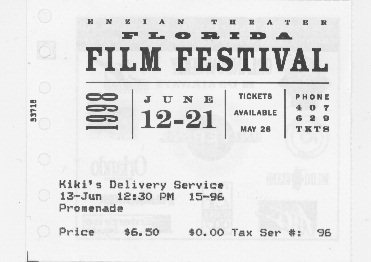Kiki's Delivery Service at the Florida Film Festival


The following is mostly commentary about our initial reactions to the Disney version of Kiki's Delivery Service and the differences between it and the original Japanese print. If you've already read our review of the film, you'll notice that some comments are repeated here. If not, you may want to read the review itself for our other thoughts on the film.
This weekend while in Orlando, FL, we got the opportunity to drop in at the Florida Film Festival. There we saw the East Coast premiere of the new Disney version of Kiki's Delivery Service. (The national premiere, you may recall, was at the Seattle Film Festival last month. The film was apparently also on screen in Nashville at the same time we saw it.) We can say now with certainty that Miyazaki fans can heave a collective sigh of relief. The conversion by Disney was excellent! The print we saw was pristine; as this was only the second public showing of Kiki's in the country, we expected no less, but it was a relief to see the true colors on the big screen after watching the fan-subbed Japanese version on our VCRs for so long.
The Miyazaki "Purists" who sat in front of us were obviously upset with the choice of Phil Hartman as the voice of Jiji (Kiki's cat), but we thought Hartman brought terrific personality to Jiji. We are well aware of the fact that Jiji had a feminine voice in the original version, but the change to the relatively masculine voice of Hartman was understanable, even neccessary. Jiji is a male cat, and if the Japanese recognize that male cats have female voices, that's wonerful for the Japanese. But for whatever reason, we in America think cats should have gender specific voices. So in the Japanese version Jiji sounded like a male cat to the Japanese, and in the American version Jiji sounds like male cat to Americans.
There was a lot of extra dialogue inserted, mostly by Jiji during scenes that were without dialogue altogether in the original film. Some small things got changed, mostly for the sake of propriety. (For instance, when Kiki and Ursula go hitchhiking, Ursula claims that she knows the man who eventually picks them up.)
Kirsten Dunst makes an excellent Kiki. She obviously really got into the part, and we can't say enough about the job she did. Janeane Garafalo was also good as Ursula, the artist. Perhaps the most interesting casting choice was Pamela Segall (best known these days as Bobby Hill from Fox's KING OF THE HILL) as Keto, the little boy to whom Kiki delivers a present. It was kind of fun to hear that familiar voice unexpectedly.
The Miyazaki Purists were also upset to hear that the songs at the beginning and end of the film had been replaced, but as the rights to those songs (which were hits in Japan 20 years ago) couldn't be a part of the Disney deal, we didn't see any reason to grouse about it. The replacement song is fabulous, and fits the style of Kiki quite nicely. The rescored incidental music features mostly the same themes as the original movie, with a few extras included, usually for comic effect.
The most telling thing about this screening of KIKI was the reaction of the audience. It was highly enjoyed by a friend of ours who had never seen an anime film before -- he "got a real kick out of it." The kids in the audience were equally vocal; they followed the plot without any trouble and you could hear people stop breathing during the climactic ending sequences.
Once again, this was an excellent job by Disney! We're looking forward to the other Miyazaki releases.
OR
Read our review of Kiki's Delivery Service